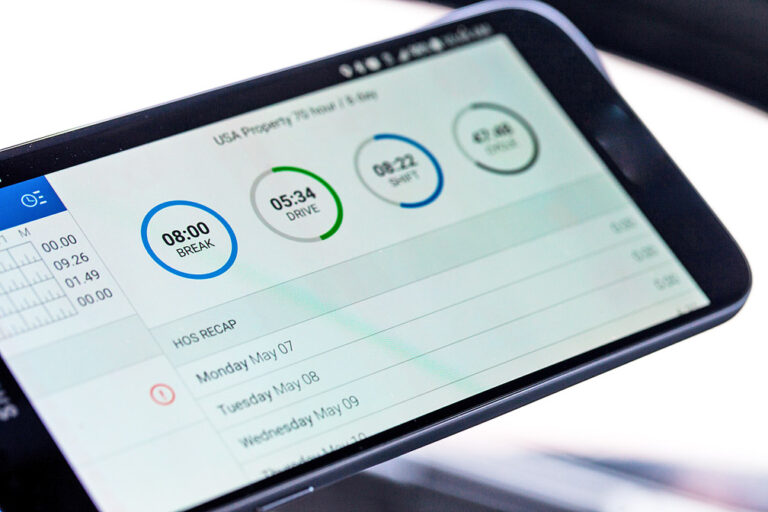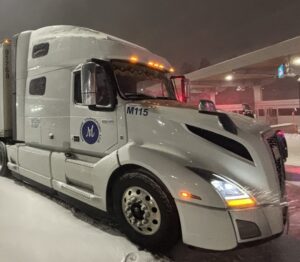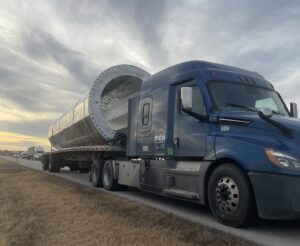WASHINGTON — The comment period on the Federal Motor Carriers Safety Administration’s (FMCSA) proposal to require trucks with pre-2000 engines to comply with the electronic logging device (ELD) mandate ended on Nov. 15 with a variety of opinions.
More than 1,300 comments were received.
Among them was a representative from The Truckload Carriers Association, who wrote that ELDs “should be required on as many trucks as possible, including rebuilt or remanufactured engines or glider kits that can accommodate ELD technology. FMCSA should push for expanded ELD adoption, because it is an important tool to track compliance for the hours-of-service regulations, which were designed to improve safety.”
On the other side, the Commercial Vehicle Safety Alliance (CVSA) wrote against the measure.
“CVSA was and continues to be a strong supporter of the ELD requirement,” the CVSA comment stated. “While expanding the ELD requirement to include these types of vehicles would bring more vehicles under the ELD requirement and help improve hours-of-service compliance and roadway safety for those vehicles, this change would be difficult to enforce, eroding any intended safety benefit.
“It is very difficult to verify roadside whether or not a vehicle is subject to the ELD regulations based on the engine manufacture date. Expanding the ELD requirements to include these vehicles will result in confusion and inconsistencies in enforcement of the regulations.”
The Owner-Operator Independent Drivers Association (OOIDA) also opposes the proposed measure.
“The agency lacks data confirming the ELD mandate has improved highway safety and has failed to demonstrate how the expansion of existing requirements to vehicles operating on pre-2000 and rebuilt pre-2000 engines would enhance safety,” the Association wrote. “OOIDA is unaware of any research that demonstrates vehicles operating under the pre-2000 exemption fail to meet the same level of safety as vehicles with ELDs.”
Many professional truck drivers are also against the proposal.
C.M. Jenkins wrote: “As an owner operator of a 1987 379 tractor I do Not want the law to change an make our trucks start using ELDs ! I believe that we should be able to remain under the current exemption due to the excessive cost an unreliability of the units that are available for manual engine trucks ! This is an unreasonable an costly issue that will put many small companies an owner operators out of business in this day an time that is one of the hardest times ever seen in the trucking industry to date to be profitable an successful !!! We have an impeccable safety record an have always strived to be compliant with saftey an customer service in mind !!”
The FMCSA’s advance notice of proposed rulemaking considers changes to the ELD mandate in five areas:
- Applicability to pre-2000 engines.
- Addressing ELD malfunctions.
- The process for removing an ELD from FMCSA’s list of certified devices.
- Technical specifications.
- ELD certification.
In 2012, Congress acted to require the use of ELDs by law. As a part of a highway funding bill, MAP-21 (Moving Ahead for Progress in the 21st century), the FMCSA was required by law to mandate ELDs. After conducting a number of studies, the rule was published in December 2015.
Dec. 18, 2017, was the deadline for most carriers to implement ELDs.
The FMCSA soon reported that, as predicted, compliance with hours-of-service regulations had improved considerably.
Drivers who had previously been able to manipulate their record-of-duty status (RODS) on paper logs (often at the behest of the carriers they worked for) found it more difficult to do so with ELDs that recorded truck movements. Carriers spent less time auditing piles of logbook pages submitted by drivers.
But then carriers began to experience what drivers had been telling them all along.
Productivity plummeted when drivers used ELDs.
For example, drivers, who were taught to “save” as many hours as possible by recording waiting time at shippers and receivers as “off duty” could no longer do so, because the ELD started the 14-hour clock as soon as the truck moved. On-duty time increased dramatically, and many drivers found that those extra on-duty hours ate into their available driving time.
Drivers who are compensated by the mile saw their earnings drop. At the same time, carriers could no longer count on established transit times and were forced to adjust schedules and deal with service failures caused by the changes. Some imposed strict time requirements on shippers and receivers to minimize the issue.
ELDs also had an impact on driver retention.
The industry was already experiencing an aging driver fleet, with the average driver age getting closer to 50 each year. In many cases, drivers who were close to or past retirement age — and unhappy over reduced income and increased oversight — decided to leave the industry.
Other drivers chose careers outside of the trucking industry.
With the mandatory use of ELDs and, at many carriers, the use of inward-facing camera systems that record the driver’s every action, new drivers are becoming harder to attract. A profession that traditionally attracts independent-minded individuals to work with a minimum of supervision is hemorrhaging drivers due to perceived micromanagement.
Another unintended consequence of the ELD mandate was a boom in sales of pre-2000 model year trucks, which have alwaysa exempt from the ELD requirement.
By law, ELDs must connect to the vehicle’s electronic control module, which records details of vehicle operation. Prior to 2000, many vehicles operated entirely by mechanical means or had simpler computer systems that did not retain operational information.
Some truck manufacturers had been offering “glider kits” — essentially new trucks without powertrains — and relying on dealers to install pre-2000 components that were usually rebuilt before installation. While these kits first appeared as cheaper alternatives to brand-new vehicles, they gained popularity for other reasons: The older engines were exempt from some of the Environmental Protection Agency’s unpopular emissions regulations that were imposed between 2000 and 2010, in addition to exempting the driver from ELD use.
Sales of trucks based on glider kits grew exponentially as carriers and independent owners sought to avoid the pitfalls of both newer engines and ELDs.
Perhaps most importantly, the safety benefits promised by ELDs didn’t materialize. As the miles traveled by large trucks and buses increased each year, so did the number of those vehicles involved in crashes, according to FMCSA statistics.
In 2015, before ELDs were mandated, the number of large trucks and buses involved in fatal crashes per 100 million miles traveled (by ALL motor vehicles) was 0.140. That number increased to 0.151 in 2016, then to 0.157 for both 2017 and 2018. The total number of fatalities reported in crashes involving large trucks or buses was 0.125 per 100 million vehicle miles in 2015. The following year it rose to 0.138, then to 0.143 for 2017 and 2018.
The FMCSA data did not include numbers for 2019 and 2020. Numbers for 2020 will likely be impacted by greatly reduced traffic due to the economic slowdown caused by the COVID-19 pandemic.
Reasons for higher crash numbers vary, but many drivers point to the lack of flexibility in the regulations. With the 14-hour clock rigidly enforced, for example, drivers who lose time waiting at docks find themselves hurrying, and sometimes speeding, to drive the required number of miles before time runs out on their shift.
In another example, the practice of avoiding peak congestion times in metropolitan areas allowed drivers to record a break (off-duty) or even a nap (sleeper berth), and then continue their journey later when traffic cleared. With the 14-hour clock ticking away on the ELD, those breaks now use up driving time. This forces the driver to keep going, increasing the risk of an accident while losing more valuable time stuck in a line of traffic.
Back in the FMCSA’s comment section, truck driver Don Henry wrote an extensive comment against the issue.
“The number 1 reason this should not happen is there is no data that shows ELD logging is safer then the truck that run paper,” he stated. “ELD logging has made Trucking more dangerous then it ever has been. Reason 2 .most of they truck that do run paper logs simply can’t afford the Additional expenses that comes with ELD’s. I have spent 34 years in Trucking and I can tell you this . If you are truly about safety on the highway and not about pushing mega carriers agenda. It starts with training before they get on the highway. All the ELDs in the world can’t teach how to handle a truck. All that is going to happen if you pass this mandate is your going to push more and more drivers out of the industry. If you say that this new rule is about safety it’s not.. look at the crashes that involve EDL equipped trucks versus non ELD or paper logging I promise the numbers with EDL equipped trucks is going to be way higher. That is the safety side not big carriers side. Thanks for your time.”
Back on the pro side, the Truck Safety Coalition wrote that it strongly urges the FMCSA to end the exemption for pre-2000 engines, and the Advocates for Highway and Auto Safety announced that the benefits from ELDs are “obvious and substantial in lives saved, crashes prevented and economic savings.”
The FMCSA will consider all comments before making a ruling on the issue.
The Trucker’s Cliff Abbott contributed to this report.
The Trucker News Staff produces engaging content for not only TheTrucker.com, but also The Trucker Newspaper, which has been serving the trucking industry for more than 30 years. With a focus on drivers, the Trucker News Staff aims to provide relevant, objective content pertaining to the trucking segment of the transportation industry. The Trucker News Staff is based in Little Rock, Arkansas.
















I don’t need some damn electronic device to tell me I need a thirty minute break or that I’m almost out of hours . I’m not a child and Do not need a babysitter the government is just mad because they can’t put their finger on everyone and make us do what they want. I’ve seen more wrecks because of the ELD and if they cut into my money the price for Trucking is gonna have to go up especially with high price of fuel , tires , and parts.
It is an infringement on our rights!-there s still crashes on these highways!-I see them almost every day!-all this does is push the particular driver to keep pushing harder and harder without regard to his natural rhythm of life, he needs to pull over to rest?-but must continue, so it forces him or her to keep going they want to driver more dastwr with no safety in mind or what that other driver s doing and the courtesy drops off and they have an attitude ” ibdont care, I need to get going!-and they do stupid /dangerous maneuvers in front of you, or want to push the other driver out of the way!-so this mandate eld s are not safe, only towards the law!& technically, nowhere safe in my books!!!
It’s why I quit
Most truck drivers that own those old trucks think they own the roads, everybody should be under the same rules. The exceptions are unfair and hurt drivers that are not exempt.
Last word, if you manage your wisely the ELD is great tool. Also prevents abusive brokers and dispatchers trying to push drivers to take loads that are running late. I want to drive less hours, I don’t want to drive 16 hours or 18 hours a day so the broker makes more money.
It’s all about money! The big mega carriers are lobbying the government for this mandate so they can push the small carriers out.
The ELD is the biggest waste of man power and truck drivers since the beginning the paper logbook and the FMCSA and all there brain dead ideas in the interest of so called highway safety’
I guarantee anyone of you that there was way more opposition to this then there was for it. but watch what happens it will pass with flying colors because of the money the mega carriers will throw at it.